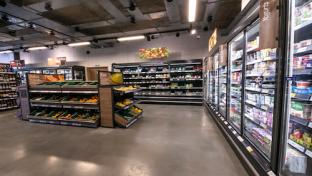Pandemic Accelerates Adoption of AI Assortment Planning
The use of artificial intelligence for assortment planning may not be widespread, but its adoption is being accelerated by a pandemic that brought about rapid change in many areas of food retail.
For example, last fall Smart & Final and Bashas’ rolled out an AI analytics platform from San Jose, Calif.-based Hypersonix to support enterprise analytics and digital transformation initiatives. The Hypersonix technology is designed to remove data silos and provides a 360-degree view of customer behaviors, localized product assortments and operational processes, to enable improved data-driven decisions.
Among the promises of new AI deployments is helping food retailers get a better handle on product assortment planning — often an area of improvisation throughout the pandemic as consumers changed shopping habits amid supply-chain challenges.
Even after the effects of the virus fade, retailers of food and consumables will continue to grow more digital, making use of ever more granular data to better forecast consumer demand — and that means a bright future for artificial intelligence.
“AI-driven intuitive analytics will play a key role in increasing conversions and profitability by analyzing consumer behavior in real time and drawing data-driven insights that can anticipate demand, drive sales, offer highly personalized promotions, improve consumer experience and avoid waste,” says Sanjeev Sularia, CEO, Intelligence Node, a real-time retail price intelligence platform. “Another key role that AI analytics will play is to gather competitive intelligence. By analyzing competitor movements in real time, retailers can make informed decisions across pricing, promotions and inventory to offer the most competitive deals to their customers and improve visibility of their products.”
Headed Toward the Mainstream
Getting to that point will require more deployments of AI at food retail, and more experimentation and experience to figure out what works best. AI is no longer just some science-fiction buzzword, of course, but it’s hardly mainstream in the food retail industry — reaching that point won’t happen in 2021. That said, the discussions about using AI to make food retail more profitable are hardly out of the ordinary anymore as more grocery operators think about how to get ahead of the competition in the coming months — and take stock of their pandemic experiences.
“Beyond 2021, there will be a significant SKU rationalization as retailers do a postmortem review of assortment planning during the pandemic, which will likely result in a cutting of many existing SKUs and the addition of many new ones,” predicts Brian Ross, president of Toronto-based Precima, A Nielsen Company. “AI can analyze all of the transaction log data from before and during the crisis, combine it with other variables that accurately imitate the changes in consumer behavior due to the pandemic, and create models for future demand that marketers and merchandisers can base their plans on.”
The embrace of artificial intelligence will happen in multiple steps — there will be no dramatic flipping of the switch, so to speak, that brings the full power of the technology into force.
“In the near term, AI-based pricing keeps retailers current with fast-changing [key value items] that have emerged during the pandemic,” notes Cheryl Sullivan, president of Burlington, Mass.-based DemandTec by Acoustic, which provides AI-based retail pricing technology. “These insights can assist assortment planners in getting the right items to the right stores to reflect current shopper demand signals, instead of just relying on hindsight with 52-week trailing demand data.”
Sullivan says that such technology can help assortment planners leverage the forecasting found in what she calls “science-based pricing, which accounts for transference of demand, including halo and cannibalization effects, that can result if an item is understocked, creating stockouts, or overstocked and languishing at the shelf.”
Longer term, the use of AI for product assortment forecasting at food retailers can also play a role in helping to design more efficient, smaller or otherwise less costly stores. Artificial intelligence additionally promises to play a bigger role in helping food retailers grow more dominant in e-commerce — a job that includes taking on massive players such as Amazon and Walmart.
“Unlike in a physical store, where prices are more or less static for days and maybe even weeks, with online shopping, prices can change rapidly — Amazon uses its dynamic pricing algorithms to review prices of millions of its SKUs, including for groceries, every two minutes,” observes Intelligence Node’s Sularia. “To thrive in this fast-paced e-commerce environment, AI-driven dynamic and competitive pricing solutions will be the only way to really optimize pricing.”
Overcoming Inertia
The use of AI for product assortment planning and related forecasts does face some significant inertia, however.
“Right now, the opportunities for product assortment planning are limitless because AI isn’t really even being used,” says Stefan Kalb, co-founder of Seattle-based Shelf Engine, whose technology is designed to reduce retail food waste. “Most buyers still rely on syndicated data, whether from IRI or Nielsen, while large retailers are stuck with national planograms because managing a radically different assortment at the individual store level, or even regional level, is too complicated.”
But times are changing — thanks in large part to the challenges of the pandemic, but also because of the increasingly digital and mobile nature of grocery consumers.
“The drastic shift in demand across nearly every category, combined with continued consumer uncertainty, will make relying on traditional data for assortment planning increasingly difficult in 2021,” notes Kalb. “While some retailers may choose to stay the course and hope for a return to pre-pandemic norms, others may see this uncertainty as an opportunity to try something new with an alternative approach.”
That alternative approach of using AI depends on retailers taking a risk with new and unfamiliar technology, he adds. That’s not always easy, of course, especially for grocery operations with relatively modest technology budgets. But the long-term payoffs can be significant, especially when one considers the potential scope of AI forecasting systems.
“AI systems allow retailers to more quickly and accurately react to unexpected shifts in product demand,” explains Kalb. “These bits of data can account for things like local weather patterns, sporting events and other external factors that impact the inexplicably varying sales cycles of some stores. AI also incorporates other types of information affecting shopping behaviors, like patterns involving complementary and competitive relationships. So, say your store is out of crackers; there’s going to be a smaller chance that shoppers will buy cheese.”
Importance of Flexibility
Consider this thought experiment: What revenue might a food retailer have gained early in the pandemic if it used AI to forecast a run on hand sanitizer and bought supplies accordingly?
“The challenge is identifying those insights faster, and being flexible enough to execute,” says Matt Schwartz, CEO of San Francisco-based Afresh, whose AI technology focuses on accurately ordering fresh food to increase sales and reduce waste.
The challenge is also knowing what you’re looking for via AI forecasting technology — that is, knowing exactly how to use this new tool.
“AI is really, really good at optimizing decisions within areas where there is a lot of data,” observes Schwartz. “As a result, with granular sales history, a machine-learning model can learn the effects of assortment, and use that learning to predict an optimized assortment going forward.”
He adds: “‘Optimized’ here usually means profit maximizing, but can also consider maximization of customer lifetime value, revenue maximization and other factors.”
As Schwartz puts it, human decision-making also is important, depending on the retail function, as experienced, insightful workers will sometimes know more than the machine.
“This is especially true in the perimeter, where product attributes are so dynamic — produce availability, taste and cost change so rapidly,” he says. “One example: With weekly produce ads breaking, a retailer found success in leveraging the machine to determine the optimal number of cases of raspberries per store, but allowed for discretion in dummying up the display after a load of short-shelf-life berries were received — this enabled stores to maximize their sales while minimizing shrink.”
Flexibility also matters when it comes to choosing the right AI system to deploy.
“Given how dynamic the landscape is in 2021, it’s critical for any system to be able to adapt,” advises Schwartz. “Certain AI technologies are more flexible than others — both in the construction of their algorithms as well as in the way human-centered workflows are built around them.”
Those are all massive choices for any food retailer, but at least one thing is becoming simpler about AI technology: implementation, which in turn affects cost.
“Any system implementation is not trivial, but with that said, new cloud-based software-as-a-service technologies can be adopted much faster than legacy systems of the past,” says Schwartz. “Whereas on-premise older technologies might have taken years to get off the ground, new AI technologies can be up and running in a couple months.”
AI has a way to go in food retail, but interest is building, even as best practices are scarce. You can bet, however, that AI’s impact will be felt pretty deeply before too long.
“Using AI is like going from a screwdriver to a power drill, a hammer to a nail gun,” notes Schwartz. “AI is a supercharging resource that can take almost any manual process or decision and augment it into a superhuman one.”






